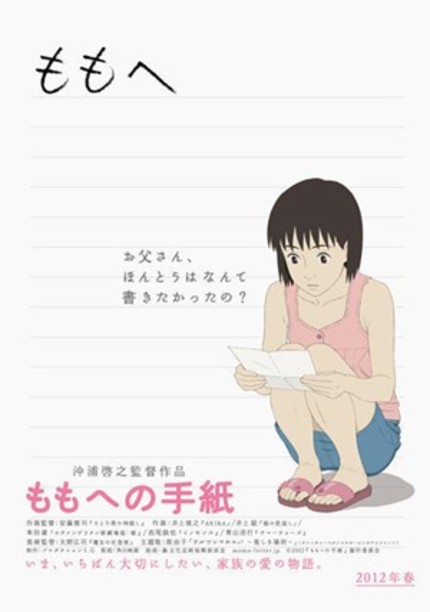Sitges 2011: A LETTER TO MOMO Review

You can't say that Hiroyuki Okiura is a prolific director. It's been more than ten years since his directorial debut with Jin-Roh and despite that film's tremendous success it's not until now that his second film sees the light.
When thinking of Japanese animation's powerhouse Production IG, you'll probably picture scenes from a dark high-tech futuristic world or maybe some sword wielding schoolgirl fighting demons. But this time the studio moves away from its more adult-oriented films to deliver A Letter To Momo, a wonderful family friendly movie along the lines of Ghibli works.
After the death of her father on a shipwreck, Momo and her mother leave the city to move to their old family house in a fishing town on a remote island where time seems to have stopped decades ago. The day before her father died Momo had an argument with him, and she never had a chance to say sorry. The only thing she has left is an unfinished letter his father left her, only containing the words "Dear Momo". She spends her days alone in the island, unable to adapt to her new life. But one day, she finds an ancient book in the attic and shortly after she starts noticing some weird silhouettes around her. As she tries to find out who these creatures are and what their mission is she will slowly discover the daily life around the island, make new friends along the way and be able to carry on with her life.
The production of A Letter To Momo took seven years to complete, and it's very easy to understand why at first glance. This film is a milestone of traditional handmade animation, with very little use of modern CG techniques. Okiura wanted to work only with the best animators in the business, and decided to wait for them to be available whenever necessary, and thus the long production time. But all this wonderful craftsmanship shines on screen, the result being a film truly beautiful to watch.
As I said before, the film manages to capture all the essence of the best Ghibli movies, and sharing more than a bunch of its familiar themes: a young child coping with loss of someone dear, the transition from childhood to adulthood and the interference of magic elements with the day to day life. And it's also one of those animated films that adults and children can enjoy, each in their own way.
It's very reassuring that after the tragic loss of such a master as Satoshi Kon, there's still plenty of talent in the Japanese animation industry. And what's more, there isn't any reason to fear for its future. A Letter To Momo is a solid proof of its health, and it'll probably be one of the best animated films of the year.
When thinking of Japanese animation's powerhouse Production IG, you'll probably picture scenes from a dark high-tech futuristic world or maybe some sword wielding schoolgirl fighting demons. But this time the studio moves away from its more adult-oriented films to deliver A Letter To Momo, a wonderful family friendly movie along the lines of Ghibli works.
After the death of her father on a shipwreck, Momo and her mother leave the city to move to their old family house in a fishing town on a remote island where time seems to have stopped decades ago. The day before her father died Momo had an argument with him, and she never had a chance to say sorry. The only thing she has left is an unfinished letter his father left her, only containing the words "Dear Momo". She spends her days alone in the island, unable to adapt to her new life. But one day, she finds an ancient book in the attic and shortly after she starts noticing some weird silhouettes around her. As she tries to find out who these creatures are and what their mission is she will slowly discover the daily life around the island, make new friends along the way and be able to carry on with her life.
The production of A Letter To Momo took seven years to complete, and it's very easy to understand why at first glance. This film is a milestone of traditional handmade animation, with very little use of modern CG techniques. Okiura wanted to work only with the best animators in the business, and decided to wait for them to be available whenever necessary, and thus the long production time. But all this wonderful craftsmanship shines on screen, the result being a film truly beautiful to watch.
As I said before, the film manages to capture all the essence of the best Ghibli movies, and sharing more than a bunch of its familiar themes: a young child coping with loss of someone dear, the transition from childhood to adulthood and the interference of magic elements with the day to day life. And it's also one of those animated films that adults and children can enjoy, each in their own way.
It's very reassuring that after the tragic loss of such a master as Satoshi Kon, there's still plenty of talent in the Japanese animation industry. And what's more, there isn't any reason to fear for its future. A Letter To Momo is a solid proof of its health, and it'll probably be one of the best animated films of the year.

Do you feel this content is inappropriate or infringes upon your rights? Click here to report it, or see our DMCA policy.





